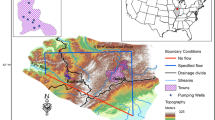Abstract.
This paper describes two groundwater models simulating a well capture zone in a heterogeneous aquifer located near an infiltrating river. A deterministic, large-scaled groundwater model (1.8 × 1.2 km) is used to simulate the average behavior of groundwater flow and advective transport. It is also used to assign the boundary conditions for a small-scaled groundwater model (550 × 400 m) which relies on stochastically generated aquifer properties based on site-specific drill core and georadar data. The small-scaled groundwater model is used to include the large subsurface heterogeneity at the location of interest. The stochastic approach in the small-scaled groundwater model does not lead to a clearly defined well capture zone, but to a plane representation of the probability of a certain surface location belonging to the well capture zone. The models were applied to a study site, which is located in an area of artificial groundwater recharge and production, in Lange Erlen near Basel, Northwestern Switzerland. The groundwater at this site contributes to the city’s drinking water supply, and the site serves as a recreational area to the population of Basel. The river is channelized, but there are initiatives to restore the riverbank to more natural conditions. However, they conflict with the requirements of groundwater protection, especially during flood events. Therefore, a river section of 600 m in the vicinity of an unused and disconnected drinking water well was restored to study changes in the groundwater flow regime depending on hydrologic variations, water supply operation data, progress of river restoration, and subsurface heterogeneity. The results of the groundwater models are compared with data from two tracer experiments using Uranine and the natural Radon isotope Rn-222, and with physical, chemical, and microbiological data sampled in monitoring wells between the river and the drinking water well. The groundwater models document significant variations regarding the dimension of the well capture zone depending on changing boundary conditions and the variability of the hydraulic aquifer properties. The knowledge of the subsurface heterogeneity is important to evaluate transport times and distances of microorganisms from the infiltrating river or the riverbank to the drinking water well. The data from the monitoring wells show that chemical and microbiological processes predominantly occur in the hyporheic interstitial zone and the riverbank within a range of a few meters up to a few 10s of meters from the river. The methods presented here can be used to define and evaluate groundwater protection zones in heterogeneous aquifers associated with infiltration from rivers under changing boundary conditions, and under the uncertainty of subsurface heterogeneity. Furthermore, they allow one to study the site-specific operational alternatives associated with river restoration.
Similar content being viewed by others
Author information
Authors and Affiliations
Additional information
Received: 16 December 2002; revised manuscript accepted: 21 March 2003
RID="*"
ID="*"Corresponding author phone: +41 61 267 3447; fax: +41 61 267 2998; e-mail: christian.regli@unibas.ch¶ Published on Web: July 3, 2003
Rights and permissions
About this article
Cite this article
Regli, C., Rauber, M. & Huggenberger, P. Analysis of aquifer heterogeneity within a well capture zone, comparison of model data with field experiments: A case study from the river Wiese, Switzerland. Aquat. Sci. 65, 111–128 (2003). https://doi.org/10.1007/s00027-003-0645-x
Issue Date:
DOI: https://doi.org/10.1007/s00027-003-0645-x




